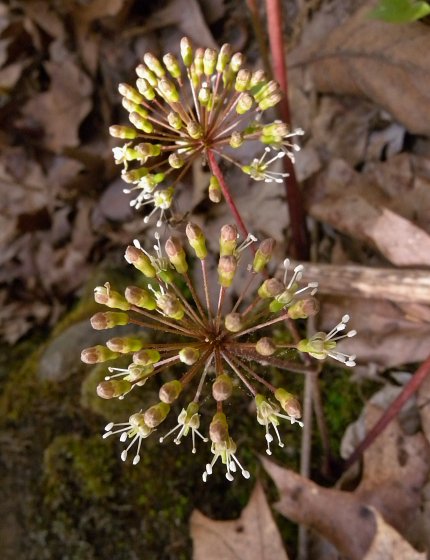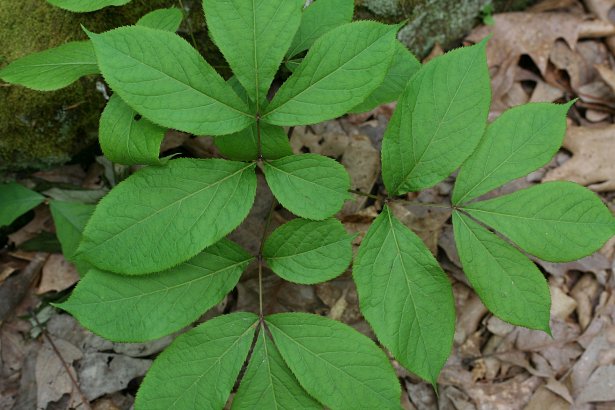Description: This perennial wildflower is about 1½' tall and 2' across. A single compound leaf and the inflorescence develop from a short stalk that is less than 1" long. The slender petiole of this leaf is about 1–1¼' long and erect; it is light green to dark red and glabrous. The blade of the compound leaf is divided into 3 segments; each of these segments is pinnately compound, consisting of 3-7 leaflets. The leaflets are up to 5" long and 2" across; they are ovate to obovate, medium green, hairless, and finely serrated along their margins. The inflorescence consists of a branching stalk of several umbels (usually 3); this inflorescence is about ¾' tall and hidden from above by the leaflets. Each globoid umbel spans about 1½–2" across, consisting of about 40 small flowers and their pedicels. The pedicels are pale green and glabrous or pubescent. Each greenish white flower is about 1/8" (3 mm.) across, consisting of 5 petals, 5 stamens, a pistil with 5 styles, and insignificant sepals. When the flower opens, the petals become strongly recurved. The strongly exerted stamens have white filaments and white anthers. The styles are very short and appressed together in the center of the flower. The ovoid-oblongoid ovary is shiny green.

The blooming period occurs during late spring to early summer and lasts about 2-3 weeks. The flowers are replaced by small blue-black berries; each fleshy berry is about ¼" across and contains 5 seeds. The root system consists of a vertical rootstock with fibrous secondary roots; long horizontal rhizomes are produced occasionally, from which clonal plants develop.
Cultivation:
The
preference is light shade, mesic conditions, and loamy, rocky, or sandy
soil containing some loose organic matter.
Range & Habitat:
The native Wild Sarsaparilla is occasional in northern Illinois,
uncommon in
west-central Illinois, and absent from the rest of the state (see Distribution
Map). Habitats include rich woodlands, rocky woodlands, sandy
woodlands, swamps, and forested bogs. This species adapts to a variety
of wooded habitats.

Faunal
Associations:
Unfortunately, information is lacking about flower-visiting insects.
The caterpillars of Papaipema araliae (Aralia Shoot
Borer Moth) bore through the stems. The berries of Aralia spp.
are eaten by some woodland songbirds, including the White-Throated
Sparrow, Swainson's Thrush, and Wood Thrush. The berries of Aralia
spp. are also eaten by some mammals, including the Red Fox,
Eastern Skunk, and Eastern Chipmunk.
Photographic Location:
A rocky woodland at The Potholes in west-central Indiana.
Comments:
At one time, the roots of Wild Sarsaparilla were used as a substitute
for genuine Sarsaparilla to flavor root beer, hence the common name of
this woodland wildflower. Wild Sarsaparilla is related to the better
known Panax quinquefolius (American Ginseng). This
latter species differs from Wild Sarsaparilla by its palmate leaflets
and red berries. Other Aralia spp. in Illinois are,
in most cases, woody shrubs or trees. An exception is Aralia
racemosa (American Spikenard), which is a much larger plant
with more leaflets (9-21) per leaf segment.